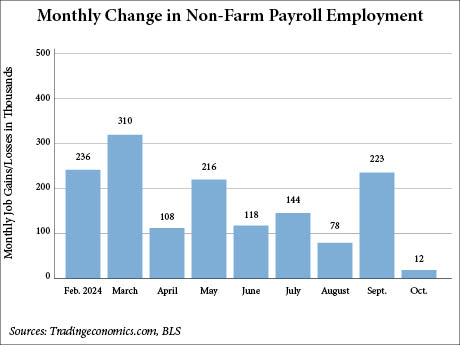WASHINGTON, D.C. — The U.S. economy added 12,000 nonfarm payroll jobs in October, according to the U.S. Bureau of Labor Statistics (BLS). This figure falls drastically short of expectations as CNBC reports that the Dow Jones economists previously predicted an increase of 100,000 jobs for the month.
In its report, the BLS noted that strike activity significantly impacted employment in the manufacturing sector, which saw the loss of 46,000 jobs. Of those jobs, 44,000 were within the transportation equipment manufacturing field, reflecting the impact of the Boeing strike. Temporary help services, a subsect of professional and business services, saw a decline of 49,000 jobs in October.
Government employment and healthcare added 40,000 and 52,000 jobs, respectively, while construction employment increased by a less significant 8,000 jobs. Other major industries saw little to no change.
The BLS report also cited the potential impact of Hurricanes Helene and Milton on October’s employment situation, though it noted that “it is not possible to quantify the net effect on the over-the-month change in national employment, hours or earnings estimate.”
The unemployment rate for October remained unchanged at 4.1 percent.
According to Lawrence Yun, chief economist of the National Association of Realtors (NAR), the jobs report reflects a slowdown in the economy, independent of one-time factors such as hurricanes and strikes.
“Today’s job report means that the Federal Reserve will make a rate cut at least one more time before the end of the year,” said Yun in a statement. “Several more cuts are also likely in 2025.”
The Federal Open Markets Committee (FOMC) will gather this week for its November meeting and decide whether or not to reduce the federal funds rate. The FOMC reduced the benchmark rate at its September meeting by 50 basis points, which marked the Fed’s first rate cut in four years.


